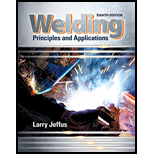
Concept explainers
Why is it important to select the correct welding code or standard?
The reason for selecting the correct welding code or standard.
Answer to Problem 1R
The reason for selecting the correct welding code or standard is to judge the quality of weld.
Explanation of Solution
A welding code or standard is a list of rules and principles that may that may be applied to certain products or items. A welding code specifies certain specifications and requirements for a particular type of weld.
These are the detailed outlines established by various agencies and organizations that explains how to lay out a particular weld, how it should be performed and tested. These detailed outlines are known as codes, standards and specifications.
Codes, standards and specifications are a list of principles, rules and regulations that are needed to ensure that skilled welders across the world can produce the same type of weld with the same level of strength, safety and reliability.
Products which are fabricated as per a welding code or standard are usually inspected and checked in order to ensure the concurrence
There are some commonly used codes for welding. These are as follows.
- API standard 1104
- ASME Section IX
- AWS D1.1
- AWS SENSE
Selection of a code or standard is done by the designers or the engineers.
A correct welding code or standard is very necessary in order to judge a weld and compare the quality of the produced welded workpiece with that of ideal sample.
Conclusion:
The reason for selecting the correct welding code or standard is to judge the quality of weld.
Want to see more full solutions like this?
Chapter 24 Solutions
Welding: Principles and Applications (MindTap Course List)
- PROBLEM 3.46 The solid cylindrical rod BC of length L = 600 mm is attached to the rigid lever AB of length a = 380 mm and to the support at C. When a 500 N force P is applied at A, design specifications require that the displacement of A not exceed 25 mm when a 500 N force P is applied at A For the material indicated determine the required diameter of the rod. Aluminium: Tall = 65 MPa, G = 27 GPa. Aarrow_forwardFind the equivalent mass of the rocker arm assembly with respect to the x coordinate. k₁ mi m2 k₁arrow_forward2. Figure below shows a U-tube manometer open at both ends and containing a column of liquid mercury of length l and specific weight y. Considering a small displacement x of the manometer meniscus from its equilibrium position (or datum), determine the equivalent spring constant associated with the restoring force. Datum Area, Aarrow_forward
- 1. The consequences of a head-on collision of two automobiles can be studied by considering the impact of the automobile on a barrier, as shown in figure below. Construct a mathematical model (i.e., draw the diagram) by considering the masses of the automobile body, engine, transmission, and suspension and the elasticity of the bumpers, radiator, sheet metal body, driveline, and engine mounts.arrow_forward3.) 15.40 – Collar B moves up at constant velocity vB = 1.5 m/s. Rod AB has length = 1.2 m. The incline is at angle = 25°. Compute an expression for the angular velocity of rod AB, ė and the velocity of end A of the rod (✓✓) as a function of v₂,1,0,0. Then compute numerical answers for ȧ & y_ with 0 = 50°.arrow_forward2.) 15.12 The assembly shown consists of the straight rod ABC which passes through and is welded to the grectangular plate DEFH. The assembly rotates about the axis AC with a constant angular velocity of 9 rad/s. Knowing that the motion when viewed from C is counterclockwise, determine the velocity and acceleration of corner F.arrow_forward
 Welding: Principles and Applications (MindTap Cou...Mechanical EngineeringISBN:9781305494695Author:Larry JeffusPublisher:Cengage Learning
Welding: Principles and Applications (MindTap Cou...Mechanical EngineeringISBN:9781305494695Author:Larry JeffusPublisher:Cengage Learning
